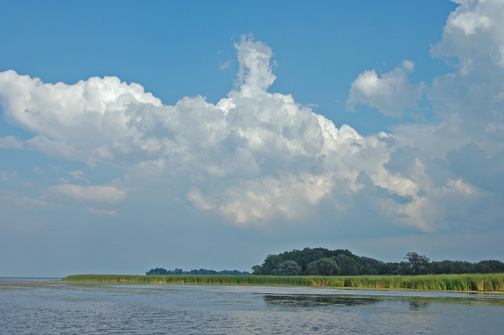Ducks Unlimited at Braddock Bay WMA
The Braddock Bay Fish and Wildlife Management Area is a 2,576 acre highly productive marsh complex consisting of five embayment ponds with associated streams, wetlands and uplands. Invasive species dominate coastal marshes at Braddock Bay and limit the growth of native plants, use by fish and wildlife, and use by the public. In spring 2014, in cooperation with our partners, the Environmental Protection Agency (EPA), SUNY-Brockport, NYSDEC, and the Town of Greece, DU received funding through the Great Lakes Restoration Initiative for Phase II work at Braddock Bay to continue efforts to prevent and control invasive species infestations, restore marsh meadow, enhance natural water flows, improve fish and wildlife habitat, and restore wetland structure by excavating channels and pools to enhance topography.
“Over Summer 2014 significant progress has been made on the Buck Pond and Buttonwood: Phase II project sites,” said Sarah Fleming, Regional Biologist. During the past six months DU cooperated with SUNY-Brockport to advance the wetland restoration. DU and SUNY-Brockport biologists collected plant community, fish, amphibian, and bird data.
Similarly, DU engineering staff completed the topographic survey and finalized restoration plans, and Town of Greece assisted with mowing and invasive species control efforts. “By Summer 2015 we anticipate completing the restoration of a minimum of 8,000 linear feet of channel, 8 acres of potholes, and 20 acres of sedge meadow habitat,” said Sarah. “SUNY-Brockport will advance with post-restoration monitoring efforts through Fall 2015.”
“DU and its partners recognize that an effective monitoring program is essential to document the short- and long-term success of the restoration efforts” said Dr. Wilcox, SUNY-Brockport. “The goal of the current partnership is to control invasive narrow-leaf cattail, simultaneously restoring sedge meadow habitat, and improving wetland interspersion in coastal marshes. SUNY-Brockport will closely monitor the efficacy of the project.”
The project will continue to expand on work recently completed by DU and its partners in Braddock Bay FWMA, Lakeview Marsh WMA, Lakeshore Marshes WMA, and the St. Lawrence region. Benefits of the restoration include improvements to local recreation and tourism resulting from an improved game bird and fisheries resources. The Braddock Bay area is an important recreational area for waterfowl hunters, anglers, birders, and hikers, and restoration of Braddock Bay will create a destination location for return users.
http://www.ducks.org/resources/media/Conservation/Conservation%20Reports/2015/New%20York%202015%20(Email).pdf
The Braddock Bay Fish and Wildlife Management Area is a 2,576 acre highly productive marsh complex consisting of five embayment ponds with associated streams, wetlands and uplands. Invasive species dominate coastal marshes at Braddock Bay and limit the growth of native plants, use by fish and wildlife, and use by the public. In spring 2014, in cooperation with our partners, the Environmental Protection Agency (EPA), SUNY-Brockport, NYSDEC, and the Town of Greece, DU received funding through the Great Lakes Restoration Initiative for Phase II work at Braddock Bay to continue efforts to prevent and control invasive species infestations, restore marsh meadow, enhance natural water flows, improve fish and wildlife habitat, and restore wetland structure by excavating channels and pools to enhance topography.
“Over Summer 2014 significant progress has been made on the Buck Pond and Buttonwood: Phase II project sites,” said Sarah Fleming, Regional Biologist. During the past six months DU cooperated with SUNY-Brockport to advance the wetland restoration. DU and SUNY-Brockport biologists collected plant community, fish, amphibian, and bird data.
Similarly, DU engineering staff completed the topographic survey and finalized restoration plans, and Town of Greece assisted with mowing and invasive species control efforts. “By Summer 2015 we anticipate completing the restoration of a minimum of 8,000 linear feet of channel, 8 acres of potholes, and 20 acres of sedge meadow habitat,” said Sarah. “SUNY-Brockport will advance with post-restoration monitoring efforts through Fall 2015.”
“DU and its partners recognize that an effective monitoring program is essential to document the short- and long-term success of the restoration efforts” said Dr. Wilcox, SUNY-Brockport. “The goal of the current partnership is to control invasive narrow-leaf cattail, simultaneously restoring sedge meadow habitat, and improving wetland interspersion in coastal marshes. SUNY-Brockport will closely monitor the efficacy of the project.”
The project will continue to expand on work recently completed by DU and its partners in Braddock Bay FWMA, Lakeview Marsh WMA, Lakeshore Marshes WMA, and the St. Lawrence region. Benefits of the restoration include improvements to local recreation and tourism resulting from an improved game bird and fisheries resources. The Braddock Bay area is an important recreational area for waterfowl hunters, anglers, birders, and hikers, and restoration of Braddock Bay will create a destination location for return users.
http://www.ducks.org/resources/media/Conservation/Conservation%20Reports/2015/New%20York%202015%20(Email).pdf

No comments:
Post a Comment